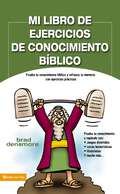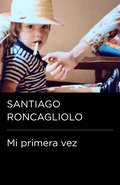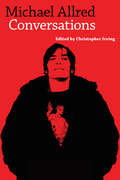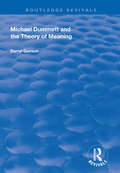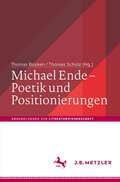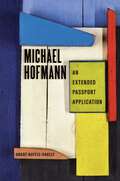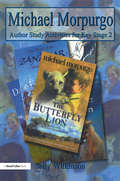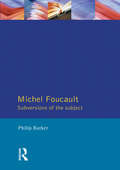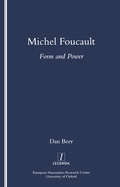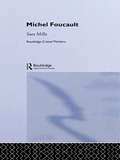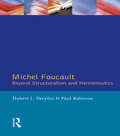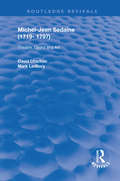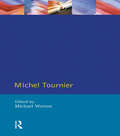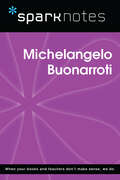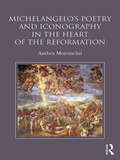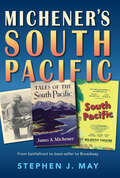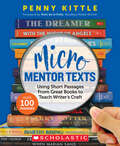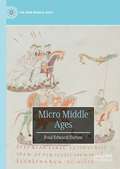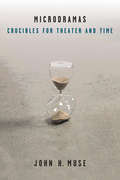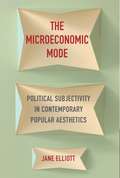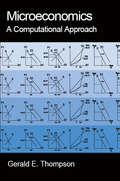- Table View
- List View
MHD7 Hindi Sanrachana - IGNOU
by IgnouSecond part of MHD-7 is about Hindi Sanrachana. This contains the following chapters. Dhwani Sanrachana, Roop, shabd aur pad, Vakya Sanrachana-one, Vakya Sanrachana-two, Arth Sanranchana, Prokti Vishleshan.
Mi hermano
by Daniel PennacLa obra más íntima de Pennac, una memoria que convierte al Bartleby de Melville en un espejo para comprender y recordar a su hermano. En su libro más personal hasta la fecha, Daniel Pennac recuerda de la manera más emotiva y original a su hermano fallecido: a través de la figura de Bartleby, el célebre escribiente de Herman Melville. Así, Pennac amplía las costuras de la literatura de duelo y se sirve de su amor por las letras para crear unas memorias preciosas. El autor parte de una certeza compartida por todos: nunca llegamos a conocer en su totalidad a nuestros seres más queridos. Con el objetivo de comprender mejor a su hermano, Pennac revisita al escribiente procrastinador de Melville, un personaje muy querido por los dos, y le convierte en una suerte de espejo en el que observar y recordar a Bernard. Así Pennac firma un libro de una ternura infinita que se convierte a la vez en una oda a la literatura. La crítica ha dicho...«Un texto de una gran belleza.»Le Figaro «El escritor rinde un bello homenaje a quien le transmitió el amor por la literatura, su hermano mayor Bernard, tan parecido al personaje de Melville.»Le Monde «Magnífica historia, un grito sobrecogedor de amor al hermano desaparecido.»L'Express «El escritor francés da voz a una dimensión íntima»Eleonora Groppetti, Corriere di Novara «La fragilidad de los supervivientes.»Nadia Terranova, Il Foglio «Pennac [...] no necesita ganarse el corazón de sus lectores. Ya está en sus corazones.»Eleonora Groppetti, Corriere di Novara «Un homenaje al hermano amado y perdido.»La Repubblica «Refinado.»Corriere di Novara «Una novela que describe la figura del hermano perdido, entre los recuerdos personales y la literatura.»La Stampa «Esta historia de construcción admirable está impregnada tanto por la ternura hacia un hermano como por el amor hacia la literatura. Jamás se ha encontrado nada mejor para prolongar la vida de los desaparecidos. Daniel Pennac lo logra con una naturalidad abrumadora.»Olivia de Lamberterie, Elle France «Con una ternura infinita, Daniel Pennac habla de la distancia y el humor de su hermano, el placer de su compañía, su presencia atenta y discreta.»Michel Abescat, Télérama «Un libro de una gran belleza melancólica donde Daniel Pennac -el seductor, el profesor que agrada a su público- abandona el centro de atención para revelar la originalidad herida, la renuncia de su hermano soñador.»Patrick Grainville, Le Figaro Littéraire
Mi libro de ejercicios de conocimiento bíblico
by Brad DensmoreDesarrolle masa cerebral al tonificar sus músculos de Matusalén. ¿Piensa que la Biblia es aburrida? ¡Piénselo de nuevo! Gran trivial bíblica le deleitará y asombrará con una colección divertida de trivialidades que cubren la Biblia entera. Desarrolle su conocimiento acerca de personas, lugares y cosas del Antiguo y Nuevo Testamentos, con pruebas de selección múltiple, listas de las diez mejores cosas, pruebas de verdadero o falso, e incluso algunas estrofas basadas en la Biblia que siguen las tonadas populares favoritas. Brad Densmore ofrece un verdadero reto de conocimiento bíblico con una dosis de humor en el camino, brindándole momentos sorprendentes tales como estos: • «¡Ay! Maneras dolorosas y desusadas de morir»: Sísara muerde el polvo después de su encuentro con el extremo puntiagudo de la estaca de una carpa. • «Lo que quiera que haga flotar su barco»: Noé tenía 600 años cuando sucedió el diluvio, ¿verdadero o falso? • «Las diez acciones de mayor valor del Antiguo Testamento»: Incluyendo Miqueasoft y Eclesiastés General. • ¿Qué tienen en común Tamar, Absalón y la sunamita? ¡Todos fueron notorios por su buena presencia! ¿Listo para hacer ejercicio? ¡Adelante! Usted no se ha divertido tanto desde que escondió un ratón en el escritorio de aquella estirada maestra de escuela dominical.
Mi primera vez (Colección Endebate #Volumen)
by Santiago RoncaglioloPara todo hay una primera vez, y Santiago Roncagliolo comparte con nosotros su primera borrachera, su primera novia, su primera clase de conducir y su primer hijo. «Las cuatro historias de Mi primera vez fueron publicadas por separado y con intenciones diversas a lo largo de quince años. Pero todas tienen en común que se nutren de mis "desvirgamientos" personales en temas de bebida, amor, paternidad y conducción segura. En todos esos ámbitos, te cuentan las reglas millones de veces, pero, llegado el momento, se te olvidan.» Tras la publicación de esas historias, muchos lectores me han dicho que encuentran en ellas sus propias primeras veces, sus nervios, sus errores, sus catástrofes. Sin duda, no somos originales ni para equivocarnos. Ahora, los lectores también me han dicho que han reído -o alguna vez llorado- con ellas. Y eso ha amortizado un poco mis propios nervios, errores y catástrofes.» Al fin y al cabo, lo único bueno de las primeras veces es poder contarlas.»Santiago Roncagliolo
Michael Allred: Conversations (Conversations with Comic Artists Series)
by Christopher IrvingMichael Allred (b. 1962) stands out for his blend of spiritual and philosophical approaches with an art style reminiscent of 1960s era superhero comics, which creates a mixture of both postmodernism and nostalgia. His childhood came during an era where pop art and camp embraced elements of kitsch and pastiche and introduced them into the lexicon of popular culture. Allred's use of both in his work as a cartoonist on his signature comic book Madman in the early 1990s offset the veiled autobiography of his own spiritual journey through Mormonism and struggles with existentialism. Thematically, Allred's work deals heavily with the afterlife as his creations struggle with the grander questions—whether his modern Frankenstein hero Madman, cosmic rock 'n' roller Red Rocket 7, the undead heroine of iZombie (co-created with writer Chris Roberson), or the cast of superhero team book The Atomics. Allred also enjoys a position in the creator-driven generation that informs the current batch of independent cartoonists and has experienced his own brush with a major Hollywood studio's aborted film adaptation of Madman. Allred's other brushes with Hollywood include an independent adaptation of his comic book The G-Men from Hell, an appearance as himself in Kevin Smith's romantic comedy Chasing Amy (where he provided illustrations for a fictitious comic book), the television adaptation of iZombie, and an ongoing relationship with director Robert Rodriguez on a future Madman film. Michael Allred: Conversations features several interviews with the cartoonist from the early days of Madman's success through to his current mainstream work for Marvel Comics. To read them is to not only witness the ever-changing state of the comic book industry, but also to document Allred's growth as a creative genius.
Michael Dummett and the Theory of Meaning (Routledge Revivals)
by Darryl GunsonPublished in 1998, this book argues that in recent decades, Anglo-American philosophy of language has been captivated by the idea that the key to progress in this area of philosophy lies in investigating the possibility of constructing a theory of meaning. This text provides an in-depth critique of the Davidsonian suggestion that Tarski's work on formal definitions of truth is an important element in allowing us to understand the form that the theory of meaning should take.
Michael Ende – Poetik und Positionierungen (Abhandlungen zur Literaturwissenschaft)
by Thomas Boyken Thomas ScholzDie Beiträge untersuchen Michael Endes Poetik und das Verhältnis des als Kinder- und Jugendbuchautor wahrgenommenen Autors zum literarischen und intellektuellen Feld der Bundesrepublik Deutschland. Dass sich Ende während seiner gesamten Schriftstellertätigkeit um die Anerkennung des literarischen und intellektuellen Feldes der Bundesrepublik bemüht hat, ist dokumentiert und Bestandteil des feuilletonistischen und akademischen Ende-Diskurses. Welche Strategien und Verfahren Ende für diesen Zweck einsetzte und in welchen Wechselbeziehungen diese zu seinem literarischen Werk stehen, wird hier erstmals systematisch untersucht. Dabei greifen die Beiträge sowohl auf Endes literarische Texte als auch auf seine (literatur-)theoretischen Reden aus, um Endes Poetik und seine Positionierungsstrategien zu konturieren.
Michael Hofmann: An Extended Passport Application
by André Naffis-SahelyFor more than four decades, Michael Hofmann has made significant contributions to the literary cultures of Germany, the United Kingdom, and the United States, ranging from his original poetry to translations of Kafka, Brecht, Hans Fallada, and Joseph Roth, among others. In the first book-length study of this iconic figure, poet and translator André Naffis-Sahely surveys Hofmann’s life and work with an emphasis on his poetry, situating him within the “New Generation” of writers, including Carol Ann Duffy, Simon Armitage, and Don Paterson, who rose to prominence in Britain between the mid-1980s and the early 1990s. Reaffirming Hofmann’s central place in contemporary literature, Naffis-Sahely presents the author’s oeuvre as an “extended passport application,” as the poet’s unusually peripatetic nature emerges as a poetic means of questioning various modes of authority. Naffis-Sahely examines Hofmann’s chief literary influences, revealing that while he was heavily inspired by the example of Robert Lowell’s confessional model, his work was equally shaped by other poetic mentors, including Ian Hamilton and Hugo Williams. In turn, Hofmann’s five published volumes of poetry—from his debut Nights in the Iron Hotel to his latest collection, One Lark, One Horse, published after a silence of two decades—chronicle the poet’s sentimental and intellectual education from adolescence to middle age, as well as the traumatic emotional experiences that arose from his relationship with his father, the German novelist Gert Hofmann, whom the poet portrayed to shocking effect in his breakthrough second collection, Acrimony. Naffis-Sahely concludes his study with an analysis of the influence Hofmann has exerted on other poets, testifying to the value and importance of his work in the contemporary British tradition, followed by an extensive interview reflecting on his career.
Michael Morpurgo: MICHAEL MORPURGO (Author Studies)
by Sally WilkinsonThis innovative series is designed to help primary teachers plan focused sessions on the work of popular, well-loved and valued authors, both classic and contemporary. Each book contains a range of activities for use directly in the classroom, covering biographical information about the author; a review of the author's work and a summary of major themes in his/her key texts; key language features of the author; frameworks to help children analyze, evaluate and compare texts, and to develop personal opinions of authors' works; ideas for writing modeled on or developed from key texts; speaking and listening opportunities; drama and role play ideas; and references to video, CD-ROM, websites and ICT activities. Inside each book is a full-color pullout poster illustrating the work of the author, which also has a set of challenges for children on the back. Michael Morpurgo is the author of over 60 books for children, including Sam's Duck, The Butterfly Lion, The Wreck of the Zanzibar, and Kensuke's Kingdom. Beginning with a detailed plan for structuring a half-term's work on Michael Morpurgo, this book presents activities that focus on narrative structure, character development, settings and themes. Activities and games include: focus on biography - writing blurbs, role-playing 'ask the author', creating a magazine article/web page about the author; exploring key themes, including bullies, not liking school, caring for animals, relationships with older people, and farm and country life; creating a character sketch; writing in role; focusing on time with a story web; analyzing setting; and an in-depth study of The Butterfly Lio.
Michael Psellos
by Stratis PapaioannouThis book explores Michael Psellos' place in the history of Greek rhetoric and self-representation and his impact on the development of Byzantine literature. Avoiding the modern dilemma that vacillates between Psellos the pompous rhetorician and Psellos the ingenious thinker, Professor Papaioannou unravels the often misunderstood Byzantine rhetoric, its rich discursive tradition and the social fabric of elite Constantinopolitan culture which rhetoric addressed. The book offers close readings of Psellos' personal letters, speeches, lectures and historiographical narratives, and analysis of other early Byzantine and classical models of authorship in Byzantine book culture, such as Gregory of Nazianzos, Synesios of Cyrene, Hermogenes and Plato. It also details Psellos' innovative attention to authorial creativity, performative mimesis and the aesthetics of the self. Simultaneously, it traces within Byzantium complex expressions of emotion and gender, notions of authorship and subjectivity, and theories of fictionality and literature, challenging the common fallacy that these are modern inventions.
Michel Foucault: Subversions of the Subject
by Philip BarkerThis unique and original study analyzes Foucault's interaction with the history of ideas, undertaking a genealogy of the subject that subverts conventional philosophical history to develop a distinctly Foucauldian intellectual history. Through a detailed account of Foucault's work and its relation to the history of ideas, Philip Barker shows how that history can be usefully reconceptualised using Foucault's concepts of genealogy and archaeology. Locating the emergence of self-reflexive consciousness in twelfth century philosophy, and elaborating upon autobiography as a philosophical persona, Barker argues that this extremely productive approach can be used to analyze the relationship between the history of philosophy, psychoanalysis and the transparent subject.
Michel Foucault: Form and Power
by Dan Beer"This is a study of the French philosopher and historian Michel Foucault's 1976 work ""La Volonte de Savoir"". Dan Beer aims to uncover a network of ideas and linguistic patterns beneath the surface of the text. Through close textual analysis he addresses the issue of language and its effects on the world we inhabit. The book covers a range of references from the forgotten narratives of 19th-century European psychiatry, examining the scope of confessional literature, to the heated debates that surround Foucault's language and ideas."
Michel Foucault (Routledge Critical Thinkers)
by Sara MillsIt is impossible to imagine contemporary critical theory without the work of Michel Foucault. His radical reworkings of the concepts of power, knowledge, discourse and identity have influenced the widest possible range of theories and impacted upon disciplinary fields from literary studies to anthropology. Aimed at students approaching Foucault's texts for the first time, this volume offers:* an examination of Foucault's contexts* a guide to his key ideas* an overview of responses to his work* practical hints on 'using Foucault'* an annotated guide to his most influential works* suggestions for further reading.Challenging not just what we think but how we think, Foucault's work remains the subject of heated debate. Sara Mills' Michel Foucault offers an introduction to both the ideas and the debate, fully equipping student readers for an encounter with this most influential of thinkers.
Michel Foucault: Beyond Structuralism and Hermeneutics
by Paul Rabinow Hubert L. DreyfusFirst Published in 1984. Routledge is an imprint of Taylor & Francis, an informa company.
Michel-Jean Sedaine: Theatre, Opera and Art (Routledge Revivals)
by David Charlton Mark LedburyOriginally published in 2000, this book highlights the interst Sedaine's life and work is now, belatedly, provoking in many scholarly disciplines. If Sedaine speaks today to literary history, theatre history and opera studies, it is because he possessed a multivalent vision, one which accounts for both his past neglect and is present rediscovery. Like many others, he believed that the established, 'official' genres needed to be reformed; unlike many, he made it his business to transform the actual language and operation of the theatre arts he practised. Until late eighteenth-century opera and drama in France become better understood, Sedaine's immense importance for the development of Romantic opera and theatre risks remaining generally concealed; to reveal something of this importance is one main reason for publishing the present volume. This book includes chapters on Sedaine and the question of genre, the representation of the female in the dramas of Sedaine, and the words, gestures and other signs in the era of Sedaine.
Michel Tournier (Modern Literatures In Perspective)
by Michael WortonThis volume of essays brings together critical analysis and commentary on the literary work of Michel Tournier.
Michelangelo Buonarroti (SparkNotes Biography Guide)
by SparkNotesMichelangelo Buonarroti (SparkNotes Biography Guide) Making the reading experience fun! SparkNotes Biography Guides examine the lives of historical luminaries, from Alexander the Great to Virginia Woolf. Each biography guide includes:An examination of the historical context in which the person lived A summary of the person&’s life and achievements A glossary of important terms, people, and events An in-depth look at the key epochs in the person&’s career Study questions and essay topics A review test Suggestions for further reading Whether you&’re a student of history or just a student cramming for a history exam, SparkNotes Biography guides are a reliable, thorough, and readable resource.
Michelangelo's Poetry and Iconography in the Heart of the Reformation
by Ambra MoronciniContextualizing Michelangelo’s poetry and spirituality within the framework of the religious Zeitgeist of his era, this study investigates his poetic production to shed new light on the artist’s religious beliefs and unique language of art. Author Ambra Moroncini looks first and foremost at Michelangelo the poet and proposes a thought-provoking reading of Michelangelo’s most controversial artistic production between 1536 and c.1550: The Last Judgment, his devotional drawings made for Vittoria Colonna, and his last frescoes for the Pauline Chapel. Using theological and literary analyses which draw upon reformist and Protestant scriptural writings, as well as on Michelangelo’s own rime spirituali and Vittoria Colonna’s spiritual lyrics, Moroncini proposes a compelling argument for the impact that the Reformation had on one of the greatest minds of the Italian Renaissance. It brings to light how, in the second quarter of the sixteenth century in Italy, Michelangelo’s poetry and aesthetic conception were strongly inspired by the revived theologia crucis of evangelical spirituality, rather than by the theologia gloriae of Catholic teaching.
Michener's South Pacific
by Stephen J. MayWhen the Japanese attacked Pearl Harbor, James A. Michener was an obscure textbook editor working in New York. Within three years, he was a naval officer stationed in the South Pacific. By the end of the decade, he was an accomplished author, well on the way to worldwide fame.Michener’s first novel, Tales of the South Pacific, won the Pulitzer Prize. Richard Rodgers and Oscar Hammerstein used it as the basis for the Broadway musical South Pacific, which also won the Pulitzer. How this all came to be is the subject of Stephen May’s Michener’s South Pacific.An award-winning biographer of Michener, May was a featured interviewee on the fiftieth-anniversary DVD release of the film version of the musical. During taping, he realized there was much he didn’t know about how Michener’s experiences in the South Pacific shaped the man and led to his early work.May delves deeply into this formative and turbulent period in Michener’s life and career, using letters, journal entries, and naval records to examine how a reserved, middle-aged lieutenant known as "Prof" to his fellow officers became one of the most successful writers of the twentieth century.
Micro Mentor Texts: Using Short Passages From Great Books To Teach Writer's Craft
by Penny KittleAt a time when students' attention is being pulled in many directions, writing expert Penny Kittle shows us the power of helping them to focus in and communicate clearly. She does that through the study of "micro mentor texts," excerpts from acclaimed books, and the decisions authors make to craft those texts so they deeply engage readers. Her book includes dozens of short texts and mini-lessons based on them--as well as many practice opportunities for students and demonstration videos for you.
Micro Middle Ages (The New Middle Ages)
by Paul Edward DuttonMicro Middle Ages brings together five microhistorical case studies focusing on small or seemingly inconsequential evidence that leads to broader conclusions about medieval history and the way we do and understand history in general. Paul Dutton provides an overview of microhistorical approaches and theorizes about its use in pre-modern history. As opposed to studying history “from above” or history “from below,” Dutton shows the advantages for historians of doing history “from the inside out,” starting from some single, overlooked, but potentially knowable thing, delving deep inside, and then reattaching it to its time and place. Such an approach has one abiding advantage: its insistence on being grounded in the particularity of the evidence. The book highlights what the microhistorical is, its conceptual and practical challenges. Dutton argues that the attention to the micro has always been with us and is a constitutive, cognitive part of who we are as human beings.
Microdramas: Crucibles for Theater and Time
by John H. MuseIn Microdramas, John H. Muse argues that plays shorter than twenty minutes deserve sustained attention, and that brevity should be considered a distinct mode of theatrical practice. Focusing on artists for whom brevity became both a structural principle and a tool to investigate theater itself (August Strindberg, Maurice Maeterlinck, F. T. Marinetti, Samuel Beckett, Suzan-Lori Parks, and Caryl Churchill), the book explores four episodes in the history of very short theater, all characterized by the self-conscious embrace of brevity. The story moves from the birth of the modernist microdrama in French little theaters in the 1880s, to the explicit worship of speed in Italian Futurist synthetic theater, to Samuel Beckett’s often-misunderstood short plays, and finally to a range of contemporary playwrights whose long compilations of shorts offer a new take on momentary theater. Subjecting short plays to extended scrutiny upends assumptions about brief or minimal art, and about theatrical experience. The book shows that short performances often demand greater attention from audiences than plays that unfold more predictably. Microdramas put pressure on preconceptions about which aspects of theater might be fundamental and about what might qualify as an event. In the process, they suggest answers to crucial questions about time, spectatorship, and significance.
The Microeconomic Mode: Political Subjectivity in Contemporary Popular Aesthetics
by Jane ElliottFrom The Road to Game of Thrones, across works as seemingly different as Gone Girl and Saw, literature, film, and television have become obsessed with the intersection of survival and choice. When the trapped rock-climber hero of 127 Hours is confronted with self-amputation or death, it is only a particularly blunt example of an omnipresent set-up. In real-life settings or fantastical games, protagonists find themselves confronting extreme scenarios with life-or-death consequences, forced to make torturous either-or choices in stripped-down, brutally stark environments.Jane Elliott identifies and analyzes this new and distinctive aesthetic phenomenon, which she calls “the microeconomic mode.” Through close readings of its narratives, tropes, and concepts, she traces the implicit theoretical and political claims conveyed by this combination of abstraction and extremity. In the microeconomic mode, humans isolated from any forms of social organization operate within a mini-economy of costs and benefits, gains and losses, measured in the currency of life. Elliott reads the key concepts that emerge from this aesthetic—life-interest, sovereign capture, and binary life—in relation to biopolitics and natural law theory, becoming and the control society, and primitive accumulation in racial capitalism. The microeconomic mode interrogates the destruction of the liberal political subject, but what it leaves in its place is as disturbing as it is radically new. Going beyond the question of neoliberalism in literature, The Microeconomic Mode combines revelatory close readings of key literary and popular texts with significant theoretical interventions to identify how an aesthetics of choice has reshaped our contemporary understanding of what it means to be human.
Microeconomics: A Computational Approach
by Gerald E. ThompsonThis concise and comprehensive introduction to economics offers readers at all levels a more realistic approach to understanding the elements of resource and product markets, including the role of business decisions; technological change; product differentiation; uncertainty; and the optimal location of activities. With the book's easy-to-use software package for computations, even non-economists will become strongly motivated and can gain a proficiency in economic analysis as well as in practical and professional decision-making skills. End-of-chapter problems, computer exercises, programming examples, and numerous diagrams further enhance the book's usefulness.


